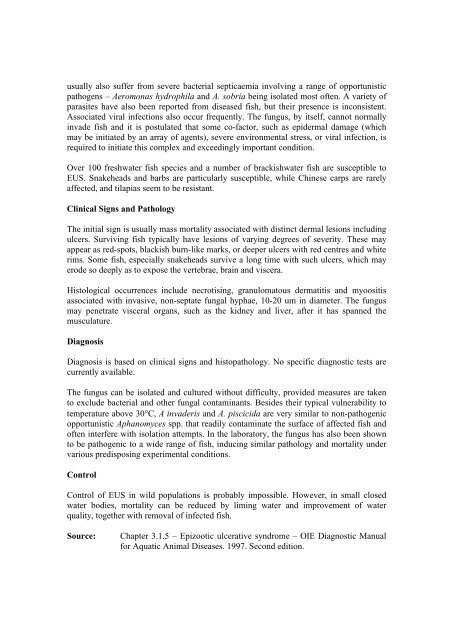Epizootic ulcerative syndrome (EUS) - Library
Epizootic ulcerative syndrome (EUS) - Library
Epizootic ulcerative syndrome (EUS) - Library
You also want an ePaper? Increase the reach of your titles
YUMPU automatically turns print PDFs into web optimized ePapers that Google loves.
usually also suffer from severe bacterial septicaemia involving a range of opportunistic<br />
pathogens – Aeromonas hydrophila and A. sobria being isolated most often. A variety of<br />
parasites have also been reported from diseased fish, but their presence is inconsistent.<br />
Associated viral infections also occur frequently. The fungus, by itself, cannot normally<br />
invade fish and it is postulated that some co-factor, such as epidermal damage (which<br />
may be initiated by an array of agents), severe environmental stress, or viral infection, is<br />
required to initiate this complex and exceedingly important condition.<br />
Over 100 freshwater fish species and a number of brackishwater fish are susceptible to<br />
<strong>EUS</strong>. Snakeheads and barbs are particularly susceptible, while Chinese carps are rarely<br />
affected, and tilapias seem to be resistant.<br />
Clinical Signs and Pathology<br />
The initial sign is usually mass mortality associated with distinct dermal lesions including<br />
ulcers. Surviving fish typically have lesions of varying degrees of severity. These may<br />
appear as red-spots, blackish burn-like marks, or deeper ulcers with red centres and white<br />
rims. Some fish, especially snakeheads survive a long time with such ulcers, which may<br />
erode so deeply as to expose the vertebrae, brain and viscera.<br />
Histological occurrences include necrotising, granulomatous dermatitis and myoositis<br />
associated with invasive, non-septate fungal hyphae, 10-20 um in diameter. The fungus<br />
may penetrate visceral organs, such as the kidney and liver, after it has spanned the<br />
musculature.<br />
Diagnosis<br />
Diagnosis is based on clinical signs and histopathology. No specific diagnostic tests are<br />
currently available.<br />
The fungus can be isolated and cultured without difficulty, provided measures are taken<br />
to exclude bacterial and other fungal contaminants. Besides their typical vulnerability to<br />
temperature above 30°C, A invaderis and A. piscicida are very similar to non-pathogenic<br />
opportunistic Aphanomyces spp. that readily contaminate the surface of affected fish and<br />
often interfere with isolation attempts. In the laboratory, the fungus has also been shown<br />
to be pathogenic to a wide range of fish, inducing similar pathology and mortality under<br />
various predisposing experimental conditions.<br />
Control<br />
Control of <strong>EUS</strong> in wild populations is probably impossible. However, in small closed<br />
water bodies, mortality can be reduced by liming water and improvement of water<br />
quality, together with removal of infected fish.<br />
Source:<br />
Chapter 3.1.5 – <strong>Epizootic</strong> <strong>ulcerative</strong> <strong>syndrome</strong> – OIE Diagnostic Manual<br />
for Aquatic Animal Diseases. 1997. Second edition.

















